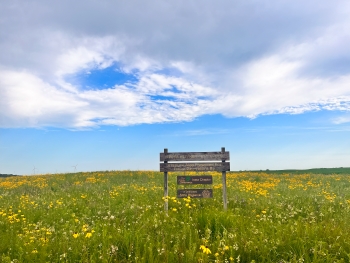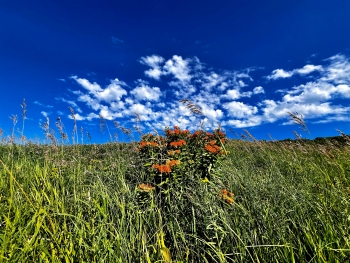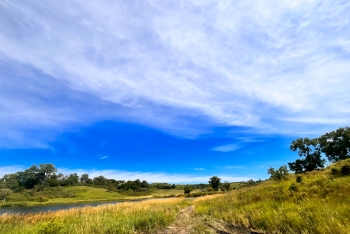
After spending five weeks in the Land of The Swamp White Oak preserve in eastern Iowa, the Anna Beal intern crew headed out to the Broken Kettle GrassLands (BKG) Preserve in Western Iowa and the Little Sioux River Valley. The preserve is situated in the Loess Hills formation, which extends south along the western border of Iowa. The BKG is a Iowa largest remnant prairie in Iowa, as well as TNC Iowa’s largest preserve. Here, we worked with new managers and staff, as well as other professionals.
 In the Little Sioux Valley, we worked on learning new skills, working to perfect them. This included pulling fence to expand accessible pasture (connecting lots together) as well as extensive chainsaw work. While we were not sawyer certified, we worked under the license of our bosses, learning how to clear lots of encroaching red cedars. By the end of the two weeks at the Little Sioux, we were able to efficiently clear large patches of red cedars (along with other species) up to 40 - 50 ft tall. While clearing trees may seem counterintuitive, they prevent the natural systems such as sand prairies from existing. With the presence of trees, the critical sand prairie habitat cannot exist, preventing the high biodiversity ecosystems from flourishing as they naturally would. Sawyer work, when paired with fire and grazing, is an extremely effective way of establishing and maintaining prairie systems back to their “original” forms.
In the Little Sioux Valley, we worked on learning new skills, working to perfect them. This included pulling fence to expand accessible pasture (connecting lots together) as well as extensive chainsaw work. While we were not sawyer certified, we worked under the license of our bosses, learning how to clear lots of encroaching red cedars. By the end of the two weeks at the Little Sioux, we were able to efficiently clear large patches of red cedars (along with other species) up to 40 - 50 ft tall. While clearing trees may seem counterintuitive, they prevent the natural systems such as sand prairies from existing. With the presence of trees, the critical sand prairie habitat cannot exist, preventing the high biodiversity ecosystems from flourishing as they naturally would. Sawyer work, when paired with fire and grazing, is an extremely effective way of establishing and maintaining prairie systems back to their “original” forms.
A large part of what makes the BKGs special is the fact that there are bison there. Much like The Land of the Swamp White Oak Preserve, grazing is an important part of the land management process in TNC. However, instead of just cattle grazing, BKG uses bison as well. While we didn’t directly work with the bison often, we did work extensively on expanding the land they had access too. Throughout our weeks at BKG, we pulled miles of fencing, allowing the bison herd to graze on more land than before. Helping the management process of the 2,000 acres of the BKG preserve. We also were fortunate enough to “cake” the bison. This is a training process of blowing a horn and throwing out feed from the back of a pickup truck. The purpose of this is to train the bison to come to the sound of the horn, which is used during round up each fall to take a headcount, health checks, and pulling bison to trade or sell to keep genetic stagnation from happening.
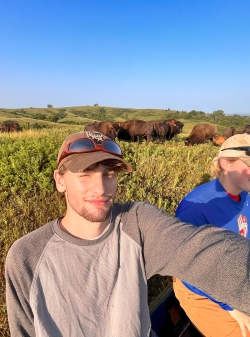

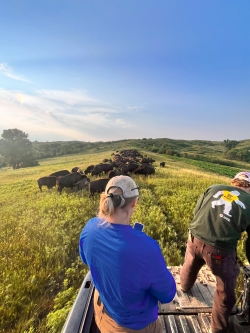
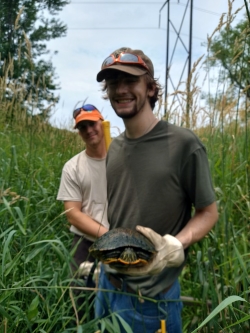
As August approached, our season with the TNC was coming to an end. Throughout the 11-week internship, we interns grew closer and learned to work as an effective team, relying on each other throughout the summer. This is an opportunity I will forever be grateful for and cannot express enough gratitude to my donors, professor, and bosses that made it possible. I also cannot thank my fellow interns enough for making it a great experience. At the end of my 11 weeks, I learned that while I love conservation work, the days I look back on with the most fondness were days in which we were working with professionals to conduct field research. This is a field in which I am hoping to explore more in the future with the faculty at Cornell as well as what other opportunities present themselves to me. I hope to keep the connections I made this summer and hopefully bring some to campus as well to expand the opportunities for other Cornell students.
